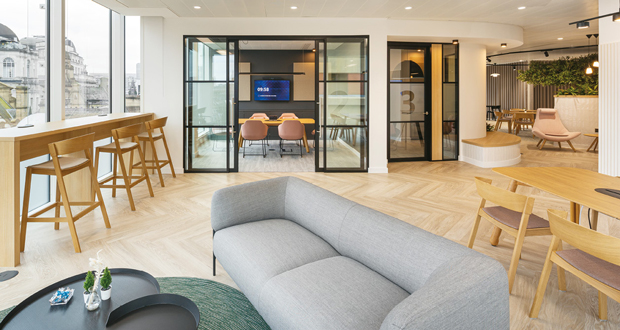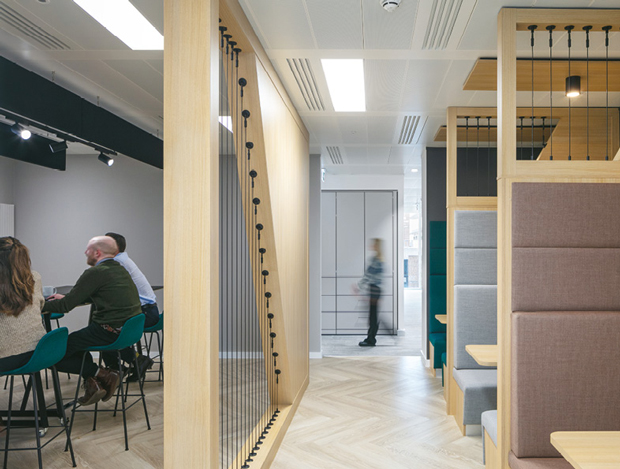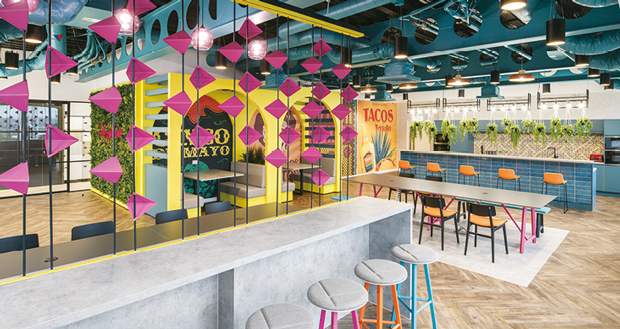LIGHTING
Research has shown that access to natural light while at work has a multitude of positive effects on employees’ physical and mental health. It helps balance circadian rhythm, which plays a crucial role in improving sleep quality, as well as regulating moods and behaviours, which boosts satisfaction levels while reducing anxiety and drowsiness.
Locating the main work areas close to windows is a natural solution to increasing proximity to natural light for employees. The use of skylights and atriums is also increasingly popular. Utilising glass for internal walls and in meeting rooms is also a good way to keep an office space light and bright, and helps minimise the need for additional lighting.
Facilities managers also need to consider that people require varying levels of lighting depending on the task they’re engaged in therefore controllable and flexible lighting solutions should be considered. For example, main open plan work areas should be well lit and bright, with additional task lighting installed where it may be required to aid focus and concentration. Ambient lighting helps to create a comfortable environment and is ideal for use in employee wellbeing rooms and relaxation areas, to encourage individuals to take time out and unwind during a stressful working day.
ACOUSTICS
Noise levels can cause discomfort and distraction for employees, particularly in open plan office environments where sound can travel easily. In fact, research shows that two thirds (66 per cent) of employees are less productive when exposed to just one nearby conversation, proving how essential acoustics of an office space are. Even with well-considered office design, it’s inevitable that in some cases, external factors such as location in a high traffic area, construction work, other building occupiers, and public transport links for example, will impact noise levels.
Features such as acoustic panels, walls, ceiling tiles, flooring, using sound-absorbing materials and even furniture, can reduce sound movement through an office, and reduce external noise. A combination of all of these is fundamental to ensuring employee comfort as well as maximising productivity. Layout of the space can also help – so providing somewhere private for people to hold meetings, having a space to work collaboratively, a quiet pod for individual work, or simply having somewhere to relax, will not only improve employee comfort but support wellbeing and satisfaction too.
AIR QUALITY
All employers have a duty under the Health and Safety at Work Act 1974 and the Workplace Regulations 1992 to provide safe and healthy air quality, and ensure that every enclosed workplace is ventilated by a sufficient quantity of fresh or purified air. This is because poor air quality can lead to a host of potential health issues, such as headaches, fatigue, and even respiratory problems.
By reducing the levels of contaminants from external pollution, as well as controlling temperature and humidity to promote air movement and prevent condensation and mould growth, you can prevent the risks associated with poor air quality. In addition, providing good air quality in workplaces is proven to have a significant impact on employee productivity and improve their alertness and ability to focus.
Air quality will vary depending on the location and nature of each workplace so when considering your ventilation strategy, you should start by carrying out a risk assessment to identify and monitor which pollutants your team may be at risk from – for example this could be external pollution, VOCs (volatile organic compounds) or even building materials if based on a construction site. Then work with an M&E expert to identify the steps you can take to minimise risk, and design an effective ventilation strategy which is tailored to your employees and their working habits.
COLOUR
The natural step for many businesses is to use colours associated with their brand within their workplace design. While this can help to create a sense of belonging for employees and nurture company culture, it’s also important to consider the influence colour psychology can have on employee behaviour.
Colour psychology refers to the way people feel when exposed to certain colours and how they influence our emotions, actions and decisions. Will matching your workplace design to your brand colour palette encourage the emotions you want employees to experience within your workplace? For example, blue is known to trigger productivity and focus, so is a natural choice for main work spaces, while red is associated with feelings of urgency but can also cause fatigue, so its overuse could have a negative impact. Greens can foster a calm and peaceful mood, so are ideal for use in relaxation areas to help create a comforting environment and encourage people to unwind. You could also make use of planting throughout the office, which will add subtle hints of green without it being overpowering.
THERE’S NO PLACE LIKE THE OFFICE
There is no doubt that the modern workplace is evolving at a rapid pace. The pandemic forced many businesses to change their operating models overnight, and the continuing emergence of new tech is driving innovations in the workplace. Coupled with the battle to attract and retain the very best talent, which is tougher than ever, the market has firmly shifted in favour of employees when it comes to workplace demands, and what they are willing to accept.
People now expect more than just a workplace – they want a home from home. Their workplace must offer a better experience than they can get at home, and organisations must react and raise the bar if they want their business to succeed.
While there are many considerations, investing in the comfort of your employees with their wellbeing in mind, you can improve workplace satisfaction, retention, and productivity, and ultimately contribute to your business’ success.







